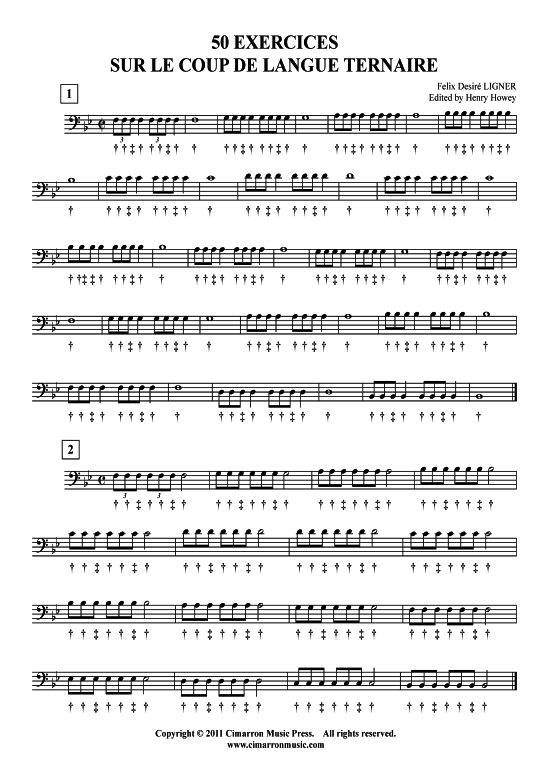50 Übungen zur Tripel-Zunge (Bariton)
- Sheet Music Download PDF
Felix Ligner





















































































50 Übungen zur Tripel-Zunge (Bariton)
- Sheet Music Download PDF
Felix Ligner
Test Print Sheet Music
Details
| Product number: | CMP1826 pdf |
|---|---|
| Arrangement: | Solo |
| Instruments: | Trombone |
| Genre: | Etüden Studien |
| Trombone: | Bariton Posaune |
| Authors: | Ligner, Felix |
| Pages: | 27 |
| duration: | : |
| Publisher: | Cimarron Music Press |
Description "50 Übungen zur Tripel-Zunge "
Auszug aus dem Vorwort:
"The triple-tongue articulation consists of separating a series of triplets.
One should practice each of the following syllables very slowly and evenly.
To pronounce the tu tu, place the tongue against the upper teeth and between the stretched and slightly open lips in such a manner that the tongue can escape to the bottom of the mouth allowing the air to enter the mouthpiece and produce the first two articulations shown above. To form the ku, hold the tongue against the lower teeth very close to the normal position. This syllable is very difficult to pronounce. Therefore one must practice it slowly and accent it in order to begin it so that it will eventually be as clear as the tu.
One should be able to produce a set of triplets in which all of the notes are equal and one cannot distinguish the ku from the tu, thus arriving at a correct performance. (Note) Exercises 8, 9, 15, 29, and 30 must be practiced especially slowly to accomplish the greatest velocity especially with evenness.
Thanks to the French Defense Ministry and Madame Dominique Hausfater (Director of the Multi-Media Library Hector-Berlioz at the Paris Conservatory), one can identify the method'snbsp author as Felix Desiré Ligner who was enlisted into the band of the Garde de Paris in 1864 as anbsp Musician Second Class at the age of twenty-two.
As a military musician, he may have been trained at the Paris Conservatory where Jean Baptiste Arban's Methode had been approved to be used for the training of military musicians in 1863. One might even speculate that Ligner was in a class that used Arban's method, if not being taught by Arban himself. Further, Ligner is thenbsp arranger of the overtures to Berlioz' Benvenuto Cellini and Mozart's Le nozze di Figaro for band. Innbsp the former arrangement, he is identified as having received an honor as a teacher however, the records that might clarify this are lost. In this book, Ligner anticipates both linguistics and speech therapy by describing the actual position of the tongue in the mouth, instead of a language-constrained alphabet.In 1867 Ligner is identified as an alto horn player in the band. Between 1869 and 1872, Ligner is identified as a cornet soloist with the band of the Garde de Paris. [...]"
0 of 0 reviews
Login

 Payment methods
Payment methods
























